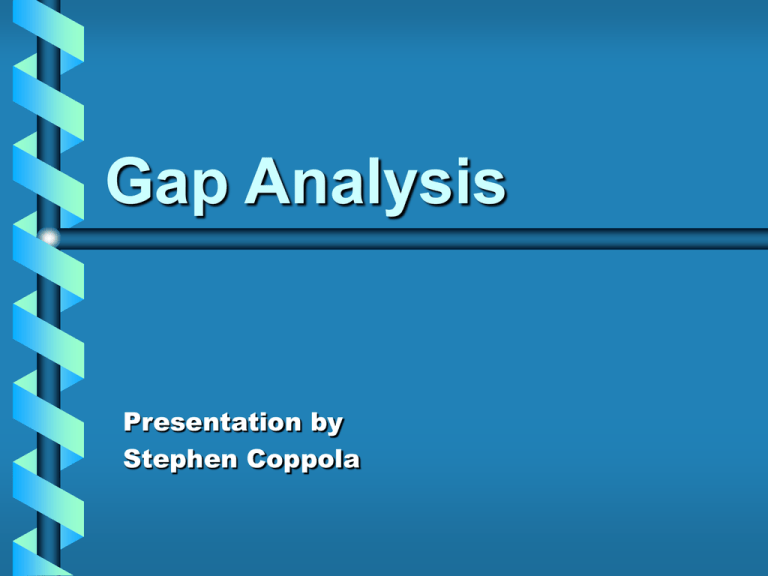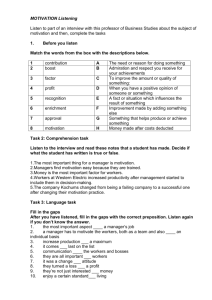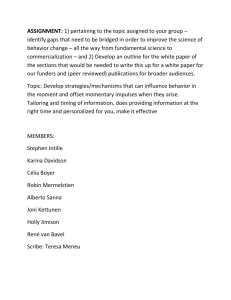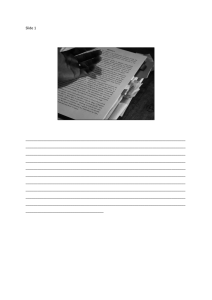Gap Analysis - FreeQuality
advertisement

Gap Analysis Presentation by Stephen Coppola Table of Contents • Definition of Gap Analysis • Service Gap Analysis • SERVQUAL – Gaps Model – Dimension Model • Real World Gap Analysis • ISO 9001 2000 2 Definition of Gap Analysis • Formal means to identify and correct gaps between desired levels and actual levels of performance • Used by organizations to analyze certain processes of any division of their company 3 Service Gap Analysis • Expected level of service vs. Actual level of service provided • SERVQUAL - 5 gaps - 5 dimensions 4 SERVQUAL • A gap analysis research instrument – created by Parasuraman, Zeithamel, and Berry – Introduced in 1988 5 SERVQUAL Model 6 SERVQUAL Model Gaps • Gap 1 – The difference between actual customer expectations and management’s idea or perception of customer expectations Management Perceptions of Customer Expectations Expected Service 7 SERVQUAL Model Gaps • Gap 2 – Mismatch between manager’s expectations of service quality and service quality specifications Service Quality Specifications Management Perceptions of Customer Expectations 8 SERVQUAL Model Gaps • Gap 3 – Poor delivery of service quality Service Delivery Service Quality Specifications 9 SERVQUAL Model Gaps • Gap 4 – Differences between service delivery and external communication with customer Service Delivery External Communications to Customers 10 SERVQUAL Model Gaps • Gap 5 – Differences between Expected and Perceived Quality Expected Service Perceived Service 11 Gaps Model 12 Gaps Model • There are 22 items which can be rated – i.e. modern looking equipment, prompt service, understanding of needs, etc. • These items are broken up into 5 dimensions: • • • • • Tangibles Reliability Responsiveness Assurance Empathy (Items (Items (Items (Items (Items 1-4) 5-9) 10-13) 14-17) 18-22) 13 Gaps Model • Perceptions and Expectations are given a rating for certain dimensions – Ratings scale • 1 (Strongly Disagree) to 7 (Strongly Agree) • Average expectation rating is then subtracted from the average perception rating 14 Gaps Model • • High negative rating High positive rating = Training needed in certain dimension = Dimension is OK, no training needed 15 Gaps Model Example For Example: • If a survey was taken which showed the averages for each dimension is as follows: Dimension Perception Average Average Tangibles 5.4 Reliability 5.6 Responsiveness 3.2 Assurance 6.2 Empathy 2.8 • What dimension should be emphasized? Expectation 2.4 4.6 3.5 3.4 4.2 16 Gaps Model Example • Perception – Expectation = Difference – – – – – Tangibles: Reliability: Responsiveness: Assurance: Empathy: 5.4 5.6 3.2 6.2 2.8 - 2.4 4.6 3.5 3.4 4.2 = = = = = 3.0 1.0 -0.3 2.8 -1.4 • Empathy has the lowest rating therefore it is the dimension where training should be emphasized the most. A focus should also be placed on Responsiveness because of its 17 negative rating. Applications of Gap Analysis • ISO 9001 2000 • Praxiom Research Group Limited • Process Approach 18 ISO 9001 2000 Gap Analysis Tool • Phase 1: Identify Gaps • Phase 2: Fill Gaps 19 ISO 9001 2000 Gap Analysis Tool Identify Gaps: • Tool lists the five sets of requirements from the ISO 9001 2000 as questions – – – – – Systematic Management Resource Realization Analytical 20 ISO 9001 2000 Gap Analysis Tool Identify Gaps: • Three answers are possible for each question: – Yes – organization has met one of ISO’s requirement – No – points to a gap – N/A – question is not applicable to situation 21 ISO 9001 2000 Gap Analysis Tool Identify Gaps: • Each time “NO” is answered, there is a column to help organization identify which processes need to be fixed • 22 total processes which can be fixed 22 ISO 9001 2000 Gap Analysis Tool Fill Gaps: • Preparation and Implementation of System Development Forms • Each of the 22 processes listed in Phase One has a system development form 23 ISO 9001 2000 Gap Analysis Tool Fill Gaps: • These system development forms are used to prepare System Development Plans • The Gap Analysis questions are turned into action statements • These action statements formulate remedial actions which will fill in the gaps 24 ISO 9001 2000 Gap Analysis Tool Fill Gaps: • Once all actions are performed and gaps are filled, the organization will have a ISO 9001 2000 compliant Quality Management System 25 Summary of Gap Analysis • Gaps can be found in any process of an organization’s operations • Tools like SERVQUAL, TwoDimensional Analysis, and ISO 9001 2000 can all be used to perform gap analysis • Gap Analysis is one of the best procedures to help lead a company to not only improve their processes, but recognize which processes are in need of improvement. 26






